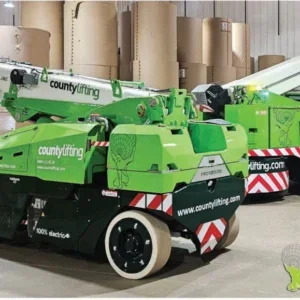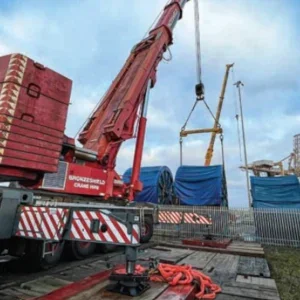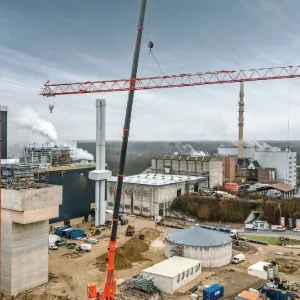Simulators can even help experienced operators practice complex lifts. Companies are using them during the hiring process to confirm a candidate’s operating abilities. And portable kits are being taken to career fairs and other events.
These systems allow students to train in environments and on complex lifts that can’t be created in the field. Scenarios of adverse weather, blind lifts and night work can be set and adjusted to prepare operators. Instructors can programme the software to test the capacity and block swing, showing students what happens when limits are met.
“Simulation really is that interim step between the classroom and actually getting onto the crane itself. I don’t think simulation would ever take away the experience an operator gains being in a real crane,” says Ted Blanton Sr., president of the North America Crane Bureau, which provides training and simulators.
Logging hours on the simulators, students get experience in situations that are too dangerous or complex to set up, and they can see the consequences of making the wrong decision without damaging equipment or endangering people. Virtualenvironments can be set for a lift to be performed next to powerlines, or in a lightning storm, for example.
“We set scenarios for failure in the system,” Blanton says. “On an overhead crane, we can set our simulator up so that at the beginning of the simulation, if they don’t check the upper limit switch, then that simulator would automatically default to a scenario where if they got into the upper limit, the block would fail and fall in front of them. And what we’ll do is we’ll have a scenario that creates a situation where they actually have to raise the block up close to the limit switch.”
It is not just for operators to see what happens when a job goes awry. Instructors can check to make sure students are following procedures, and have the hand-eye coordination and depth perception to operate a crane. Companies in the steel industry are increasingly using simulators during the hiring process to check job applicants’ crane operation skills, he says.
HeviCert, a Las Vegas-based company that provides crane operator training and certification, offers two main services. It will send trainers to do training in-house or supply turnkey courses, often forvocational schools, private companies or government education programmes, worldwide. Simulators are an integral part of the courses, explains HeviCert president Mike Martens.
“They definitely provide a lot of benefits, all the way from cost effectiveness to safety,” he says. “Once they are acquired, aside from the very insignificant electrical cost, there is no fuel cost; there’s no maintenance cost. The instructor can have a much closer interaction with the student.”
The HeviCert training programmes use simulator software from Simlog that can be downloaded on desktop computers, making it easier for trainers to travel abroad. Simulation products vary from PC applications like this to multi-screen consoles and cab replicas. Control options include using standard video game joysticks or levers and pedals from crane manufactures. Realistic virtual worksites, soundtracks mimicking cab noise and motion platforms create a nearly authentic experience.
There is a drastic difference between two people who have come out of a classroom, when one of them has had simulator training, says Blanton. “The person who had 30, 40, 50 hours of time on the simulator would be much smoother in operations when he gets into the crane itself.”
Beyond training, simulators offer an opportunity for experienced operators to practice new techniques. The Operating Engineers Training Institute of Ontario (OETIO), which offers crane operator training courses, has worked with visual simulation company Vortex to develop training simulators that are linked together and allow operators to practice a two- crane lift, explains OETIO executive director Harold McBride.
It is a popular scenario for simulation because of the growing wind power industry and windmill tower erection, in Canada and worldwide, he says. “The two-crane lift is something that needs a lot of practice. You have to be in sync with the other operator.”
It is no different from the simulation training used in the Air Force or for commercial airline pilots, McBride explains. “What they’re doing in training is putting their new pilots through complex scenarios. And what OETIO has done is we’ve made sure that our new apprentices going out into the industry have experienced complex scenarios through simulation. [We provide for] any new operator that has to go out into the industry and experience complicated lifts. These lifts should be practiced through simulation first. And that’s the way the industry is going.”
ARI Simulation
ARI Simulation provides crane simulation training for construction cranes, port and terminal cranes, ship-based cranes, rig and offshore cranes and various heavy lift cranes. Options range from PC-based solutions to multiple PC, instructor-controlled, full mission solutions on motion platforms. These simulators provide realistic reproductions of the visual, behavioral and operational characteristics, says ARI. A typical crane simulator includes a replica operator cabin, seat, high fidelity visual system and sound system.
The operator station has a realistic, out-of-cabin view, and ARI can develop environments to customer specification. The visual system is completely integrated with the simulation exercise, motion, sound system and crane controls to provide the necessary depth in the visual perspective, explains ARI.
Simulators allow operators to go through start-up and shutdown procedures, boom operation, cabin rotation, limit switches and tandem lifts among other exercises, depending on crane type. Stations can be set up in classroom or container configuration. Crane controls emulate those in a real crane and are designed as plug and play modules that can be swapped out based on the crane type, make and model. Optional motion platforms are available for the operator cabins.
For monitoring trainees, instructor stations have CCTV camera views of the operator cabin, stealth view to zoom in for debriefing and an interface for editing and runtime views. Instructors can operate the simulator in real time— inserting faults, emergencies and failures—and then pause or replay the exercise and communicate with the operator; or they can use an edit mode to create and save training scenarios. Weather, daylight and shadows can be adjusted, and the system tracks productivity and safety. All of this information is logged and stored.
ARI’s crane simulator can be configured to integrate with its other simulation products for users to create simulation training exercises between different disciplines. For example users can simulate a rig crane being used to load/unload a platform supply vessel, or a personnel transfer between vessels using crane baskets. In these exercises, both the crane operator and the vessel handler share the same simulation experience, and the actions of one affects the other.
GlobalSim
GlobalSim has recently introduced a new configuration into its MasterLift Crane raining simulators based on a multicrane training system it delivered last year to Northrop rumman Shipbuilding.
The system networked together several portal cranes within the simulator to assemble large ship components. By using the technology developed for this project, GlobalSim expanded the model to perform multicrane lifts in the general construction industry,specifically a multi-crane lift training system for the erection of wind power generators.
Operators can realistically construct the entire wind generator in the virtual world prior to building one in the real world. The software has been designed for the virtual construction of an entire wind generator, from erection of the tower sections to installation of the nacelleassembly and blades. “The only thing you can not do with the model is generate actual electricity,” says Clyde Stauffer, senior vice president of GlobalSim.
Two virtual cranes are controlled by two separate sets of operator controls in the simulation training. Both of these cranes use the appropriate hardware controls required to construct the virtual wind generator. Manipulation of the load by one of the cranes has a direct effect on the handling of the load by another.
The multi-lift crane model has been initially implemented on a mobile lattice crane configuration, and GlobalSim is in the process of adding it to both its rough terrain crane and hydraulic telescopic crane configurations.
MeVEA
MeVEA offers three training simulators— basic, advanced and pro—for maritime andharbour cranes. The evaluation, equipment and exercises vary between the three, but all training simulators are produced to customer specification.
The basic training simulator provides all the functions needed to get familiar with controlling the machine in order to practice operations using a simplified control interface with visual feedback from the monitors.
MeVEA suggests this can be used in the preliminary stages of training and to select trainees for further training. The package includes one PC and two monitors, a simple control interface (10 control signals from USB-controllers), a simple virtual environment, a simple audio environment (five sounds, no customised sound recordings), basic training exercises tailored with the customer and time-based task evaluation.
In the advanced training simulator, many of these features are upgraded to include large screens, a more advanced audio system and a more realistic virtual environment for the trainee to practice several working tasks. The control interface is more detailed and a motion platform is optional.
This package provides an enhanced environment where the trainee will be forced to adapt to various failure scenarios and weather conditions, explains Tero Eskola, managing director, MeVEA. Standard features of the advanced training simulator are two PCs, two monitors, three screens and projectors (to create the views from the side of the cab), training exercises to customer preference and three different evaluation variables (time, collisions and trajectories).
The pro package is MeVEA’s most immersive simulator using two PCs, two monitors, four screen and projector combinations, and a motion platform. Customised bus interfaces can be built to connect the training simulator with customers’ own control/sensor hardware. Customers can have the virtual environment and the training exercise tailored to their needs. The difficulty of the exercises can be adjusted and the progress of the trainee can be precisely tracked. The exercises can be repeated as many times as needed without binding existing machinery, explains Eskola. “Handling the realistic machine will not only increase productivity but also safely offer the trainee experience of hazardous situations,” he says.
MeVEA is in the process of developing software for tower and mobile crane simulators. These will include electrical motion platforms, surround sound, HDvisualisation systems, cabins with controls, armchairs and workstations for teachers to control training exercises, weather, etc. Eskola estimates the systems could be ready as early as autumn 2010.
North American Crane Bureau
Among its training offerings, the North American Crane Bureau (NACB) sells simulators for mobile telescopic boom cranes, overhead bridge cranes and, recently introduced, tower cranes. The simulator systems are composed of a student station and one for the instructor.
The student has crane controls (wired pendant, radio pendant, mobile crane controls, etc) and a 3D view of the simulated training area. The 3D view is updated 30 times per second and is displayed on a user-supplied LCD projector or monitor. The instructor station has a flat-panel monitor, keyboard and mouse to control the simulation.
The mobile crane system simulates a 40t telescopic boom crane, and the new tower crane system simulates a hammerhead tower crane. Both are in a cab console with integrated engine and outrigger controls. There are lever and joystick controls, load moment indicators, engine and hydraulic system gauges, foot pedals and the necessary software.
Testing can be done in various modes of expertise, and analysis and record keeping is built in. Parameters such as wind, speed, intensity, rain, lighting and time of day can be set. Various training scenarios can be used, including a construction site, highway bridge or powerlines.
On the simulator, operators can do preoperational control checks, execute proper load positioning, control swing and check safety systems. The system also creates the opportunity for users to react to hand signals and recognise hazards and perform hazard abatement.
NACB also presents the annual Professional Development Conference for crane, hoist and rigging safety and compliance. One of the events is the Annual Simulator Rodeo; attendees can compete on either the mobile telescopic crane or overhead bridge crane simulator, and a champion of each will be named.
Simlog
Simlog’s personal simulators for mobile and tower cranes are set up on PCs by installing the software and simulator controls. The controls can be off-the-shelf PC controls, replicas of controls used on the job with industrial components (USB connection) or OEM controls using parts from the operator controls of real heavy equipment.
The software puts users at the controls of a typical mobile hydraulic crane equipped with telescoping boom and job and a variety of loads and hook blocks. Instrument readings are displayed including boom angle, boom length, height, radius, quadrant of operation and a simulated load moment indicator. Alternatively, there is software for a freestanding top-slewing tower crane with trolley jib. Instrument readings include working slew angle, working radius, lowering depth (hook height), and load weight. There is also a simulated three-way switch for hoist gear selection.
There are six simulation modules of increasing difficulty. Early modules introduce the basic crane motions, working up to obstacles and load charts and ending with zigzag trajectory following exercises. Key performance indicators measure how quickly and how carefully the simulated work is performed, including execution time, maximum load sway, number of load/obstacle collisions, and number of two-blocking occurrences. In this way, the feedback is diagnostic, instead of just a consolidated pass/fail score, explains Simlog. Simulation results are automatically saved, so trainees can progress at their own pace without trainer supervision.
Simlog offers replica controls with eight pushbuttons and tabletop mounting brackets to create an operator chair set-up. Pricing for the software is a one-time fee per PC, and it can be used on both laptops and desktop computers.
Vortex
Vortex simulators are available for truck, crawler, tower cranes and a variety of offshore and port cranes. There are various series and options to choose from depending on expertise levels. These range from a full training centre with real crane controls, a cab-like enclosure, multiple HD displays, and an instructor’s station to an entry-level training platform with simplified controls.
The construction crane simulators are based on a topslewing Liebherr 63LC for tower cranes, a Grove RT530E mobile crane and a Manitowoc 8500 crawler. To create an interactive virtual environment, simulators create ambient cab noises and have a real-time control panel. Realistic clouds, fog, shadows and wind prepare students for actual construction site conditions, explains Vortex. ‘Trainees gain valuable experience practicing multiple realistic hoist and move scenarios, with and without obstructions.’
Working with OETIO, Vortex developed the technology to link two simulators together to allow operators to practice two-crane, synchronised lifts for windmill erection.
Multi-user technology has also been developed to allow an entire operations team to train together. The operator works in a simulated crane cab, receiving signals on screen from the banksman. From the screen the operator sees the worksite and load, and can rely on the banksman in a blind lift. The banksman uses an avatar to walk through the virtual site, erect barriers and observe the working conditions while in radio contact with the operator. The slinger directs his avatar to walk through the worksite, perform safety inspections of lifting gear and loads.
If anything goes wrong, the slinger can record the incidents. They can also sling the load for the operator to perform the lift, and pull on tag ring lines to help land the load. Scenarios are recorded for playback and evaluation. Instructors can also participate, walking through the worksite, triggering equipment faults, altering weather conditions and viewing team performance.
Antycip represents and supports Vortex products in Europe.






